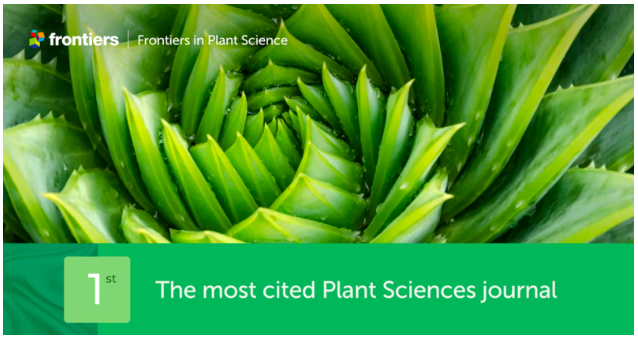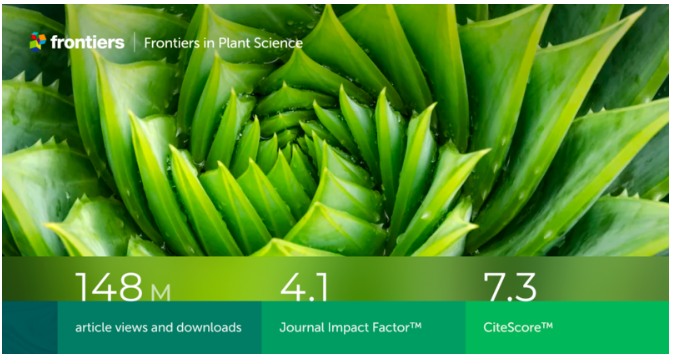博文
新文速递 | Frontiers in Plant Science 最新发表文章速览(一)
||

Frontiers in Plant Science 是一本由科学家主导的开放获取期刊,由中国科学院植物研究所刘春明教授担任主编,并由相关领域的杰出科研人员组成编委团队,共同致力于传播有影响力的科学知识和重大发现。备受全球植物科学领域研究者的支持与肯定。期刊最新影响因子为 4.1,CitesScore 为 7.3。
期刊目前包含植物育种、植物非生物胁迫、植物病原互作、植物生理、植物细胞生物学、功能植物生态学等 24 个栏目方向,其中植物代谢、植物生物信息学、智慧植保、植物功能基因组学、光合作用和光生物学等栏目主编由中国科学院植物生理生态研究所李来庚教授、广西大学陈玲玲教授、南京农业大学舒磊教授、农科院作物科学研究所李慧慧教授、中国科学院植物生理生态研究所朱新广教授分别担任。

我们整理了近期发表在 Frontiers in Plant Science 的文章,综合其影响力,评选出具有代表性的文章共 24 篇,以飨读者。本文为第一篇,将推荐选读其中的前 6 篇研究,为方便深入了解,每篇均附精要导读,以下为导读原文:
01
两种光强下红光和白光在优化医疗大麻生长及植物特异性代谢物积累中的作用
The role of red and white light in optimizing growth and accumulation of plant specialized metabolites at two light intensities in medical cannabis (Cannabis sativa L.)
文章导读
The cultivation of medical cannabis (Cannabis sativa L.) is expanding in controlled environments, driven by evolving governmental regulations for healthcare supply. Increasing inflorescence weight and plant specialized metabolite (PSM) concentrations is critical, alongside maintaining product consistency.
Medical cannabis is grown under different spectra and photosynthetic photon flux densities (PPFD), the interaction between spectrum and PPFD on inflorescence weight and PSM attracts attention by both industrialists and scientists. Plants were grown in climate-controlled rooms without solar light, where four spectra were applied: two low-white spectra (7B-20G-73R/Narrow and 6B-19G-75R/2Peaks), and two high-white (15B-42G-43R/Narrow and 17B-40G-43R/Broad) spectra. The low-white spectra differed in red wavelength peaks (100% 660 nm, versus 50:50% of 640:660 nm), the high-white spectra differed in spectrum broadness.
All four spectra were applied at 600 and 1200 μmol m(-2) s(-1). Irrespective of PPFD, white light with a dual red peak of 640 and 660 nm (6B-19G-75R/2Peaks) increased inflorescence weight, compared to white light with a single red peak of 660 nm (7B-20G-73R/Narrow) (tested at P = 0.1); this was associated with higher total plant dry matter production and a more open plant architecture, which likely enhanced light capture. At high PPFD, increasing white fraction and spectrum broadness (17B-40G-43R/Broad) produced similar inflorescence weights compared to white light with a dual red peak of 640 and 660 nm (6B-19G-75R/2Peaks).
This was caused by an increase of both plant dry matter production and dry matter partitioning to the inflorescences. No spectrum or PPFD effects on cannabinoid concentrations were observed, although at high PPFD white light with a dual red peak of 640 and 660 nm (6B-19G-75R/2Peaks) increased terpenoid concentrations compared to the other spectra. At low PPFD, the combination of white light with 640 and 660 nm increased photosynthetic efficiency compared with white light with a single red peak of 660nm, indicating potential benefits in light use efficiency and promoting plant dry matter production.
These results indicate that the interaction between spectrum and PPFD influences plant dry matter production. Dividing the light energy in the red waveband over both 640 and 660 nm equally shows potential in enhancing photosynthesis and plant dry matter production.
原文链接👇
| https://www.frontiersin.org/journals/plant-science/articles/10.3389/fpls.2024.1393803/full?utm_source=chnweb&utm_medium=social&utm_content=kxw02&utm_campaign=webpromochn |
02
剖析热胁迫在田间条件下对硬粒小麦的影响
Dissecting the effect of heat stress on durum wheat under field conditions
文章导读
Introduction: Heat stress negatively affects wheat production in several ways, mainly by reducing growth rate, photosynthetic capacity and reducing spike fertility. Modeling stress response means analyzing simultaneous relationships among traits affecting the whole plant response and determinants of grain yield. The aim of this study was to dissect the diverse impacts of heat stress on key yield traits and to identify the most promising sources of alleles for heat tolerance.
Methods: We evaluated a diverse durum wheat panel of 183 cultivars and breeding lines from worldwide, for their response to long-term heat stress under field conditions (HS) with respect to non stress conditions (NS), considering phenological traits, grain yield (GY) and its components as a function of the timing of heat stress and climatic covariates. We investigated the relationships among plant and environmental variables by means of a structural equation model (SEM) and Genetic SEM (GSEM).
Results: Over two years of experiments at CENEB, CIMMYT, the effects of HS were particularly pronounced for the normalized difference vegetation index, NDVI (-51.3%), kernel weight per spike, KWS (-40.5%), grain filling period, GFP (-38.7%), and GY (-56.6%). Average temperatures around anthesis were negatively correlated with GY, thousand kernel weight TKW and test weight TWT, but also with spike density, a trait determined before heading/anthesis. Under HS, the correlation between the three major determinants of GY, i.e., fertile spike density, spike fertility and kernel size, were of noticeable magnitude.
NDVI measured at medium milk-soft dough stage under HS was correlated with both spike fertility and grain weight while under NS it was less predictive of grain weight but still highly correlated with spike fertility. GSEM modeling suggested that the causal model of performance under HS directly involves genetic effects on GY, NDVI, KWS and HD.
Discussion: We identified consistently suitable sources of genetic resistance to heat stress to be used in different durum wheat pre-breeding programs. Among those, Desert Durums and CIMMYT’80 germplasm showed the highest degree of adaptation and capacity to yield under high temperatures and can be considered as a valuable source of alleles for adaptation to breed new HS resilient cultivars.
ty with the degree of saturation was tested.
原文链接
| https://www.frontiersin.org/journals/plant-science/articles/10.3389/fpls.2024.1393349/full?utm_source=wechat&utm_medium=social&utm_content=kxw03&utm_campaign=webpromochn |
03
GranoScan:一款用于田间识别小麦所受生物威胁的 AI 驱动移动应用程序
GranoScan: an AI-powered mobile app for in-field identification of biotic threats of wheat
文章导读
Capitalizing on the widespread adoption of smartphones among farmers and the application of artificial intelligence in computer vision, a variety of mobile applications have recently emerged in the agricultural domain. This paper introduces GranoScan, a freely available mobile app accessible on major online platforms, specifically designed for the real-time detection and identification of over 80 threats affecting wheat in the Mediterranean region.
Developed through a co-design methodology involving direct collaboration with Italian farmers, this participatory approach resulted in an app featuring: (i) a graphical interface optimized for diverse in-field lighting conditions, (ii) a user-friendly interface allowing swift selection from a predefined menu, (iii) operability even in low or no connectivity, (iv) a straightforward operational guide, and (v) the ability to specify an area of interest in the photo for targeted threat identification.
Underpinning GranoScan is a deep learning architecture named efficient minimal adaptive ensembling that was used to obtain accurate and robust artificial intelligence models. The method is based on an ensembling strategy that uses as core models two instances of the EfficientNet-b0 architecture, selected through the weighted F1-score. In this phase a very good precision is reached with peaks of 100% for pests, as well as in leaf damage and root disease tasks, and in some classes of spike and stem disease tasks. For weeds in the post-germination phase, the precision values range between 80% and 100%, while 100% is reached in all the classes for pre-flowering weeds, except one.
Regarding recognition accuracy towards end-users in-field photos, GranoScan achieved good performances, with a mean accuracy of 77% and 95% for leaf diseases and for spike, stem and root diseases, respectively. Pests gained an accuracy of up to 94%, while for weeds the app shows a great ability (100% accuracy) in recognizing whether the target weed is a dicot or monocot and 60% accuracy for distinguishing species in both the post-germination and pre-flowering stage. Our precision and accuracy results conform to or outperform those of other studies deploying artificial intelligence models on mobile devices, confirming that GranoScan is a valuable tool also in challenging outdoor conditions.
原文链接👇
| https://www.frontiersin.org/journals/plant-science/articles/10.3389/fpls.2024.1298791/full?utm_source=wechat&utm_medium=social&utm_content=kxw04&utm_campaign=webpromochn |
04
基因组不一致性伴随真双子叶植物花对称性的进化:罂粟科的案例研究
Genomic incongruence accompanies the evolution of flower symmetry in Eudicots: a case study in the poppy family (Papaveraceae, Ranunculales)
文章导读
Reconstructing evolutionary trajectories and transitions that have shaped floral diversity relies heavily on the phylogenetic framework on which traits are modelled. In this study, we focus on the angiosperm order Ranunculales, sister to all other eudicots, to unravel higher-level relationships, especially those tied to evolutionary transitions in flower symmetry within the family Papaveraceae.
This family presents an astonishing array of floral diversity, with actinomorphic, disymmetric (two perpendicular symmetry axes), and zygomorphic flowers. We generated nuclear and plastid datasets using the Angiosperms353 universal probe set for target capture sequencing (of 353 single-copy nuclear ortholog genes), together with publicly available transcriptome and plastome data mined from open-access online repositories.
We relied on the fossil record of the order Ranunculales to date our phylogenies and to establish a timeline of events. Our phylogenomic workflow shows that nuclear-plastid incongruence accompanies topological uncertainties in Ranunculales. A cocktail of incomplete lineage sorting, post-hybridization introgression, and extinction following rapid speciation most likely explain the observed knots in the topology. These knots coincide with major floral symmetry transitions and thus obscure the order of evolutionary events.
原文链接
| https://www.frontiersin.org/journals/plant-science/articles/10.3389/fpls.2024.1340056/full?utm_source=wechat&utm_medium=social&utm_content=kxw05&utm_campaign=webpromochn |
05
生态系统工程师可调节相关植物物种的资源分配策略
Ecosystem engineers can regulate resource allocation strategies in associated plant species
文章导读
Balancing the biomass requirements of different functions for the purpose of population reproduction and persistence can be challenging for alpine plants due to extreme environmental stresses from both above- and below-ground sources. The presence of ecosystem engineers in alpine ecosystems effectively alleviates microenvironmental stresses, hence promoting the survival and growth of other less stress-tolerant species.
However, the influence of ecosystem engineers on plant resource allocation strategies remains highly unexplored. In this study, we compared resource allocation strategies, including biomass accumulation, reproductive effort (RE), root fraction (RF), as well as relationships between different functions, among four alpine plant species belonging to Gentianaceae across bare ground, tussock grass-, cushion-, and shrub-engineered microhabitats. Shrub-engineered microhabitats exerted the strongest effects on regulating plant resource allocation patterns, followed by tussock grass- and cushion-engineered microhabitats.
Additionally, apart from microhabitats, population background and plant life history also significantly influenced resource allocation strategies. Generally, plants established within engineered microhabitats exhibited higher biomass accumulation, as well as increased flower, leaf and stem production. Furthermore, individuals within engineered microhabitats commonly displayed lower RF, indicating a greater allocation of resources to above-ground functions while reducing allocation to root development. RE of annual plants was significantly higher than that of perennial plants. However, individuals of annual plants within engineered microhabitats showed lower RE compared to their counterparts in bare ground habitats; whereas perennial species demonstrated similar RE between microhabitat types.
Moreover, RE was generally independent of plant size in bare-ground habitats but exhibited size-dependency in certain populations for some species within specific engineered microhabitat types. However, size-dependency did exist for absolute reproductive and root biomass allocation in most of the cases examined here. No trade-offs were observed between flower mass and flower number, nor between leaf mass and leaf number. The capacity of ecosystem engineers to regulate resource allocation strategies in associated plants was confirmed. However, the resource allocation patterns resulted synergistically from the ecosystem engineering effects, population environmental backgrounds, and plant life history strategies. In general, such regulations can improve individual survival and reproductive potential, potentially promoting population persistence in challenging alpine environments.
原文链接👇
| https://www.frontiersin.org/journals/plant-science/articles/10.3389/fpls.2024.1387951/full?utm_source=wechat&utm_medium=social&utm_content=kxw06&utm_campaign=webpromochn |
06
针对低投入农业的水稻育种
Rice breeding for low input agriculture
文章导读
A low-input-based farming system can reduce the adverse effects of modern agriculture through proper utilization of natural resources. Modern varieties often need to improve in low-input settings since they are not adapted to these systems. In addition, rice is one of the most widely cultivated crops worldwide.
Enhancing rice performance under a low input system will significantly reduce the environmental concerns related to rice cultivation. Traits that help rice to maintain yield performance under minimum inputs like seedling vigor, appropriate root architecture for nutrient use efficiency should be incorporated into varieties for low input systems through integrated breeding approaches.
Genes or QTLs controlling nutrient uptake, nutrient assimilation, nutrient remobilization, and root morphology need to be properly incorporated into the rice breeding pipeline. Also, genes/QTLs controlling suitable rice cultivars for sustainable farming. Since several variables influence performance under low input conditions, conventional breeding techniques make it challenging to work on many traits. However, recent advances in omics technologies have created enormous opportunities for rapidly improving multiple characteristics.
This review highlights current research on features pertinent to low-input agriculture and provides an overview of alternative genomics-based breeding strategies for enhancing genetic gain in rice suitable for low-input farming practices.
原文链接👇
| https://www.frontiersin.org/journals/plant-science/articles/10.3389/fpls.2024.1408356/full?utm_source=wechat&utm_medium=social&utm_content=kxw07&utm_campaign=webpromochn |

Frontiers in Plant Science 是瑞士出版社 Frontiers 旗下的开放获取期刊,目前位于 JCR 植物科学分区 Q1,中国科学院分区生物学 2 区 top,植物科学 2 区。期刊最新影响因子为 4.1,CitesScore 为 7.3。期刊目前拥有 24 个专栏,涵盖了从作物分子遗传学、细胞生物学和生理学到生态学、进化生物学和植物病原学等各个领域,利用计算机科学、光学、分子生物学、生物化学和基因组学等的最新发展,来探讨植物细胞、个体、种群、到生态系统过程及其背后机制。

END
Frontiers 总部位于瑞士,是全球领先的开放获取(Open Access)出版商,致力于使科学在全球范围内更加开放,其发布的研究文章已被浏览和下载超过 28 亿次。欲了解更多详情,欢迎访问 Frontiers 官方网站:www.frontiersin.org.
https://blog.sciencenet.cn/blog-3465500-1458036.html
上一篇:Frontiers 近期专刊征稿汇总 | Frontiers in Nutrition
下一篇:乳腺癌突破:五大前沿专刊推动早期检测与治疗进展